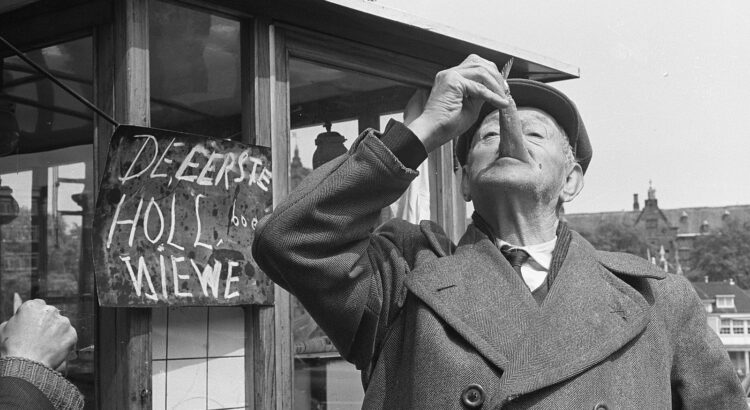Every year in the Netherlands, you can treat yourself to eating a special kind of herring called: Hollandse Nieuwe. This special delicacy is either hated or loved and is eaten straight from the hand. The fish is dipped in some diced onions, you hold it above your head and then you take a bite. Or, if you’re from Amsterdam, it will be cut up in pieces and served with onions and pickles. But sliced or eating it whole, the herring should be fatty, silty and tender… Delicious!
The ‘Hollandse Nieuw’ must be caught and sold between the first of May until the last day of August. In that period the herring is in a biological stage, that gives the fish it’s unique taste. This has to do with the fat percentage of the herring, it must be at least Sixteen percent. If the first fish with that fat percentage is caught and ready to be sold, the Hollandse Nieuwe season is opened. This biological stage of the fish gives the herring the name ‘maatjesharing’. ‘Maatje’ is an alteration for‘maagd’, the Dutch word for virgin. The ‘maatjesharing’ is a herring that, at the point of the catch, is not reproductive.
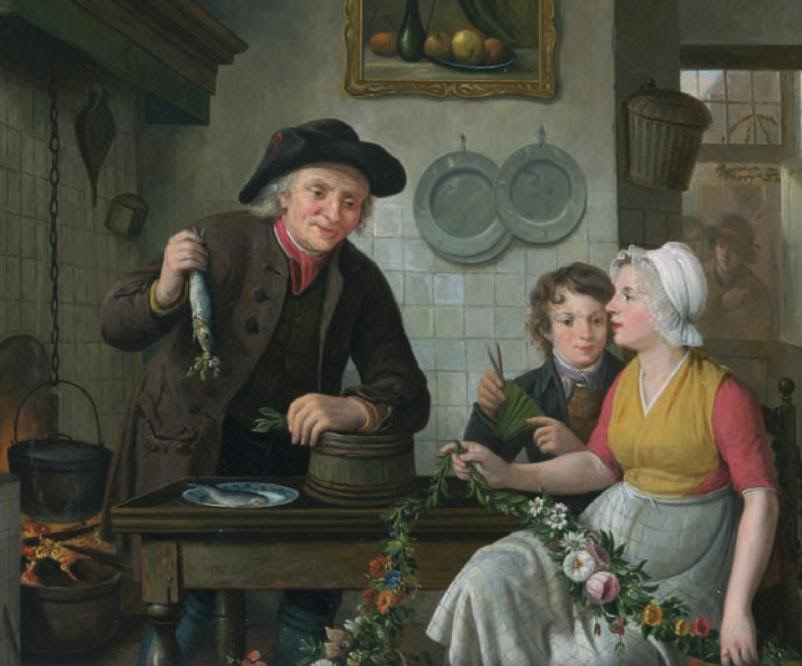
The Old ‘Hollandse Nieuwe’
Catching and eating herring is something that the Dutch do since the Middle Ages. And especially in the 16th– and 17th-century the Dutch fished for a lot of herring. It was an important part of the Dutch economy. For centuries the people in Amsterdam ate herring for breakfast. But the preservation technique, that makes the ‘Hollandse Nieuwe’ so special, is a lot older. The technique is called ‘kaken’ and it make the herring last for about a year. With ‘kaken’ the intestines are taken out of the fish, except for the pancreas. The pancreas has special enzymes which make the fish ferment a little bit, giving the herring its special flavor. Once the intestines have been removed, the herring is placed in a barrel with salt.
The preservation method has its roots in medieval times and in Dutch folklore the creation of this method is attributed to Willem Beukelszoon, a fisherman from Biervliet. A chronicler writes in the sixteenth century that Willem Beukelszoon invented a new way of treating herring and earlier in 1483 this method is also accredited to the same man. But this is most likely a legend, because a similar method of preserving fish can be traced back to Scandinavia well before 1300. Fish was preserved on the Scandinavian shore, now the southwest of Sweden, and shipped to other parts of Europe.
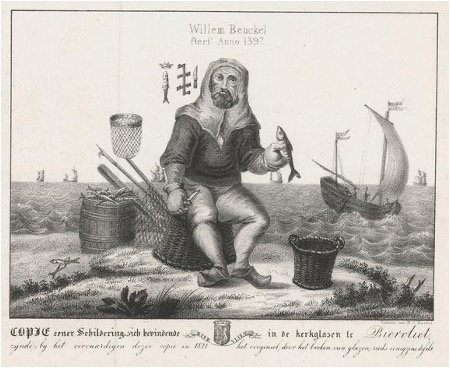
But at the end of the 14th century, the Low Countries started to fish and sell more and more herring. This is because the method used in the Low Countries differentiated from the Scandinavian method in one way: the fish was cured on the boats. The reason for fishermen to immediately conserve the fish on the boats, is because they could fish further from the Dutch coast. Going northward on the North-Sea, as far as Scotland and Scandinavia, without the herring going bad. In the 14th century Low Countries, fishermen already knew the best period to catch herring was from May through July. This is when the herring finds the best food in the North-Sea, which gives the fish the most fat and makes it the optimal herring for ‘kaken’.
Celebrating The Herring

The process of catching herring and preserving stays more or less the same for hundreds of years. In the nineteenth century, saying goodbye to the ships that set sail for herring fishing, got a celebration day that became known as ‘vlaggetjes dag’. The herring fishing season was the time the economy went upwards. This is why ‘vlaggetjes dag’ was celebrated in the poor fishermen’s environment. The celebration slowly faded from existence until it was picked up again after the Second World War. It got an official status in 1947. The harbor was decorated with flags and every year they celebrated the fishermen setting sail. This is done until the fishing ships got modernized. The celebration switched from the ships taking off, to the first herring arriving in the Netherlands. In the picture above, you can see fishermen proudly showing the first ‘Hollandse Nieuwe’ of 1958 in Scheveningen. Still to this day, every year the coming of the herring calls for celebration.
Not The Same As It Was
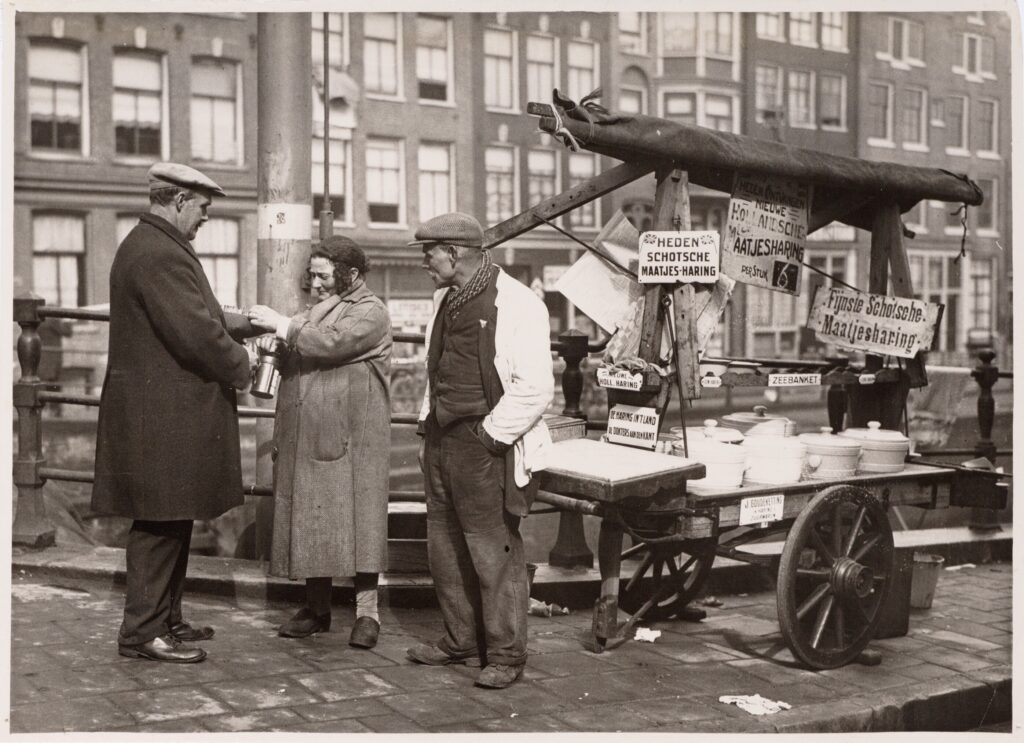
The term ‘Hollandse Nieuwe’ first appears in newspapers in the 1930’s. On this picture from the 1930’s, you can see this fish stand selling herring and sours. He is selling ‘Nieuwe Hollandsche Maatjesharing’ or New Dutch herring. Eating the first ‘Hollandse Nieuwe’ stays popular and people are standing in line for the first one of the year. Look at these pictures down below from the end of May in 1955. On the sign of the stand – very similar to today’s fish stands – it says: ‘the first “Hollandse Nieuwe” 50 cents.’ The man with the moustache is waiting before he also enjoys a herring. Today people are still excited to eat their first ‘Hollandse Nieuwe’ of the year, but the herring today is different from the one they ate in the fifty’s.
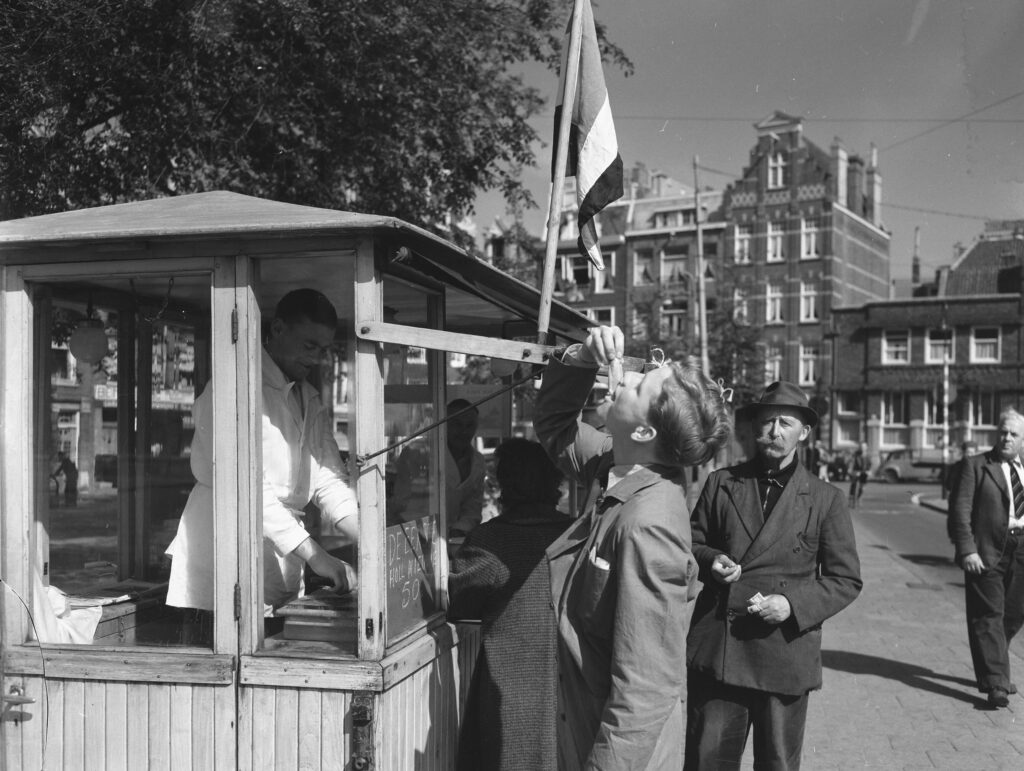
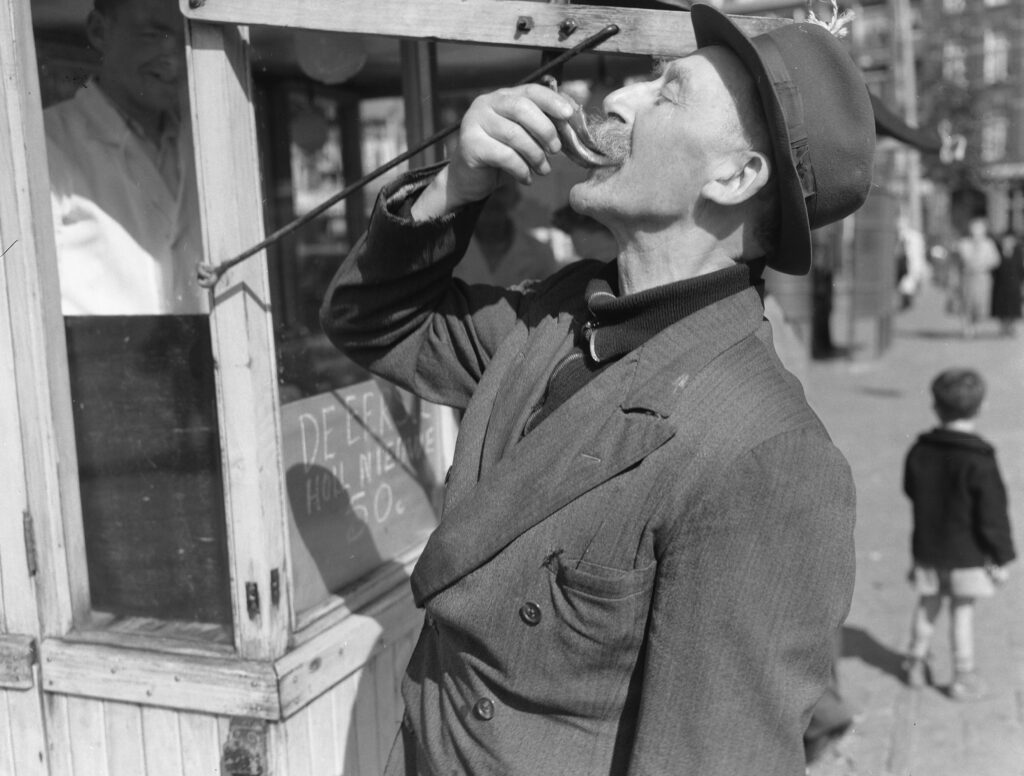
The fishing and preservation technique was continued for a long time, but from 1977 fishermen were not allowed to fish for herring in the North-sea until 1983. The effects of this law are still seen today. The herring had to be bought from elsewhere, for the most part from Norway. From all the ‘Hollandse Nieuwe’ eaten today more than half is imported from Norway. The ‘kaking’ still happens, but now on land in Norwegian factories. After the processing on land the herring is frozen and shipped to the Netherlands.
There is some irony in the change of preservation method. From a medieval Scandinavian method, that was developed to an ‘on ship’ procedure. Now 700 years later the ‘kaking’ happens on shore again in Scandinavia. But besides this change of preservation, I’m still exited for the new ‘Hollandse Nieuwe’. Are you?
Written by Brent Sickmann
Further reading:
– Richard W. Viator, The Netherlands Herring Fishery in the Late Middle Ages: The False Legend of Willem Beukels of Biervliet.
– Product specialty certificate – RVO
